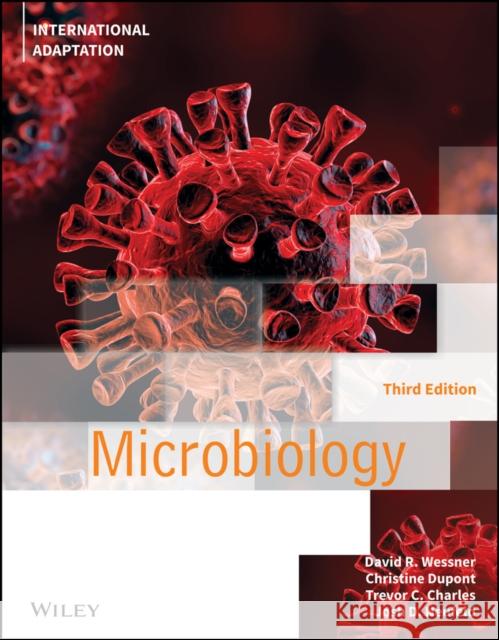Microbiology » książka



(netto: 322,03 VAT: 5%)
Najniższa cena z 30 dni: 292,18
ok. 30 dni roboczych.
Darmowa dostawa!
PART I The Microbes1 The Microbial World1.1The MicrobesMini-Paper: A Focus on the Research The Three Domains of LifeToolbox 1.1 Polymerase Chain Reaction Amplification of rRNA Genes1.2Microbial Physiology, Genetics, and CultivationOutlook 1.1 Creating Life in the Laboratory: The Miller-Urey Experiment1.3Microbial Ecology and Biotechnology1.4 Microbes Associated with Diseases2 Bacteria and Archaea2.1Morphology of Bacterial CellsOutlook 2.1 Making the Microbiology Laboratory Accessible2.2The Cytoplasm2.3The CytoskeletonMini-Paper: A Focus on the Research Magnetosomes: Uncovering the Structure of Bacterial Organelles2.4The Cell EnvelopeToolbox 2.1 The Gram StainOutlook 2.2 The Protective Shells of Endospores2.5The Cell Surface2.6 Evolution of Archaea2.7 Morphology of Archaeal Cells2.8Diversity of Bacteria and ArchaeaMini-Paper: A Focus on the Research The Role of Archaea in Our Digestive SystemOutlook 2.3 Extremophiles and Biotechnology3 Eukaryotic Microorganisms3.1Structure of Eukaryotic CellsMini-Paper: A Focus on the Research Lipid Rafts: Organized Clustering of Lipids within a MembraneToolbox 3.1 Using Microscopy to Examine Cell StructureOutlook 3.1 Hijacking the Cytoskeleton3.2Diversity of Eukaryotic Microorganisms3.3Replication of Eukaryotic Microorganisms3.4The Origin of Eukaryotic CellsOutlook 3.2 Secondary endosymbiosis: The origins of an organelle with four membranes3.5Interactions Between Eukaryotic Microorganisms and Animals, Plants, and the Environment4 Virology4.1A Basic Overview of VirusesMini-Paper: A Focus on the Research New Findings in the Packaging of DNA by the Model Bacteriophage T44.2Origins of VirusesOutlook 4.1 Ribozymes: Evidence for an RNA-Based World4.3Cultivation, Purification, and Quantification of VirusesToolbox 4.1 Cell Culture TechniquesOutlook 4.2 Measurement of HIV Viral Load4.4Diversity of VirusesToolbox 4.2 Reverse Transcriptase Polymerase Chain Reaction (RT-PCR)4.5Virus-Like Agents4.6Present Prospective in Virology5 Microbial Metabolism5.1Acquisition of Carbon, Energy, and Electrons5.2Energy, Enzymes, and ATPOutlook 5.1 Who Needs Vitamins?5.3ATP Synthesis5.4Metabolism of Glucose Carbon Sources5.5Respiration and the Electron Transport SystemOutlook 5.2 Electricigenic Bacteria and Microbial Fuel Cells5.6Metabolism of Non-glucose Carbon SourcesToolbox 5.1 Metabolism and Rapid Bacterial Identification Systems5.7Phototrophy and PhotosynthesisMini-Paper: A Focus on the Research Genome Sequence of a Deep Sea Symbiont5.8Metabolism of Nitrogen and Sulfur5.9Biosynthesis of Cellular ComponentsPART II Microbial Genetics6 Cultivating Microorganisms6.1Factors Affecting Microbial GrowthToolbox 6.1 Phenotype Microarrays for Examining Microbial Growth6.2Growing Microorganisms in the LaboratoryOutlook 6.1 The Discovery of Helicobacter pyloriToolbox 6.2 FISHING for Uncultivated MicroorganismsMini-Paper: A Focus on the Research Bringing to Life the Previously Unculturable Using the Soil Substrate Membrane System (SSMS)6.3Measuring Microbial GrowthOutlook 6.2 Mycobacterium leprae, An Extraordinarily Slow-growing PathogenOutlook 6.3 The Human Intestine: A Continuous Culture6.4Preventing Microbial Growth7 DNA Replication and Gene Expression7.1The Role of DNA7.2Replication of DNAMini-Paper: A Focus on the Research Telomeres with Promoter Activity7.3TranscriptionToolbox 7.1 Using a Gel Shift Assay to Identify DNA-binding Proteins7.4Translation7.5The Effects of MutationsOutlook 7.1 Using Mutations to Control Viral Infections8 Viral and their Replication8.1Recognition of Host CellsOutlook 8.1 Identifying Emerging Viral PathogensToolbox 8.1 The Western Blot8.2Viral Penetration and Uncoating8.3Viral ReplicationMini-Paper: A Focus on the Research The Discovery of Reverse TranscriptaseOutlook 8.2 Phage Therapy: Biocontrol for Infections8.4Viral Assembly and Release9 Bacterial Genetic Analysis and Manipulation9.1Bacteria as Subjects of Genetic Research9.2Mutations, Mutants, and StrainsToolbox 9.1 Isolating Nutritional Mutants9.3Restriction Enzymes, Vectors, and Cloning9.4Recombination and DNA TransferOutlook 9.1 Plasmids That Produce PathogensMini-Paper: A Focus on the Research The Discovery of Transduction10 Microbial Genomics10.1Genome SequencingOutlook 10.1 Rate of DNA SequencingToolbox 10.1 Genome databases10.2Genomic Analysis of Gene Expression10.3Comparative GenomicsMini-Paper: A Focus on the Research Genome Sequence of a Killer BugOutlook 10.2 The Minimal Genome10.4Functional Genomics and Related Analyses11 Regulation of Gene Expression11.1Differential Gene Expression11.2The OperonMini-Paper: A Focus on the Research Tuning Promoters for Use in Synthetic Biology11.3Global Gene RegulationOutlook 11.1 The Use of Lactose Analogs in Gene Expression Studies11.4Post-Initiation Control of Gene ExpressionToolbox 11.1 Using RNA molecules to decrease gene expression11.5Quorum Sensing and Biofilm formation11.6Two-Component Regulatory Systems11.7ChemotaxisPART III Microbial Physiology and Ecology12 Microbial Ecosystems12.1Microbes in the Environment12.2Microbial Community AnalysisToolbox 12.1 Flow CytometryOutlook 12.1 Naming the Uncultured and UncharacterizedMini-Paper: A Focus on the Research Insights into the Phylogeny and Coding Potential of Microbial Dark Matter12.3Aquatic EcosystemsOutlook 12.2 Dead Zones12.4Terrestrial Ecosystems12.5Deep Subsurface and Geothermal Ecosystems13 Symbiotic Microbiome13.1Types of Microbe-Host Interactions13.2Plant MicrobiomeOutlook 13.1 The Possible Impossible Vegan Patty13.3Human MicrobiomeToolbox 13.1 Germ-free and Gnotobiotic AnimalsOutlook 13.2 Food Probiotics--Do They Work?Mini-Paper: A Focus on the Research Fecal Bacteriotherapy: "Repoopulation" of the Gut13.4Herbivore's MicrobiomeOutlook 13.3 Midichlorians--Not Just for JediOutlook 13.4 Death of Coral Reefs14 Biogeochemical Cycles14.1Nutrient CyclingToolbox 14.1 Using Microarrays to Examine Microbial Communities: The GeoChip14.2Cycling Driven by Carbon MetabolismOutlook 14.1 CO2 as a Greenhouse Gas and Its Influence on Climate Change14.3Cycling Driven by Nitrogen MetabolismMini-Paper: A Focus on the Research The First Isolation and Cultivation of a Marine Archaeon14.4Other Cycles and their ConnectionsOutlook 14.2 Life in a World without MicrobesOutlook 14.3 The Microbiology of Environmentally Toxic Acid Mine DrainageToolbox 14.2 Biogeochemistry in a Bottle: The Winogradsky Column15 Microbial Biotechnology15.1Microorganisms for BiotechnologyOutlook 15.1 Bioprospecting: Who Owns the Microbes?15.2Genetic EngineeringToolbox 15.1 Site-Directed MutagenesisToolbox 15.2 Fusion Protein Purification
1997-2026 DolnySlask.com Agencja Internetowa
KrainaKsiazek.PL - Księgarnia Internetowa









